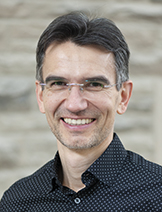Stan Metchev, Professor and Canada Research Chair

Contact Information
Office: PAB 201
Tel: 519 661-2111, 88438
E-mail: smetchev@uwo.ca
Research Areas
Brown dwarfs, extrasolar planets, low-mass stars, trans-Neptunian objects, robotic telescopes, space telescopesResearch Interests
Brown dwarfs---giant planets' more massive kin---offer a convenient probe of exoplanetary atmospheres. With sizes and temperatures similar to those of known exoplanets, the atmospheres of brown dwarfs are governed by comparable dynamics, and exhibit similar characteristics: clouds, zonal winds, and storms. Multi-wavelength photometric and spectroscopic monitoring of brown dwarfs can reveal the vertical and longitudinal temperature structure of storms in substellar atmospheres. Such observations have also been the first ones to probe the atmospheric dynamics of extrasolar planets. Much like low-mass stars, brown dwarfs may also host planetary systems in their own right. These are expected to contain mostly rocky, potentially Earth-like exoplanets. The discovery of rocky planets around low-mass stars and brown dwarfs is a top priority in Dr. Metchev's research, and the subject of the POET micro-satellite mission, in development with the Canadian Space Agency.
Trans-Neptunian objects are the leftover debris from the formation of our own solar system. The largest of these (Pluto, Charon, Quaoar, Eris) are over 1000 km in size and are well-known. No objects smaller than 10 km are known as they are too small to see in reflected or thermal emission even with the most sensitive telescopes. Yet, these small kilometre-sized TNOs account for the vast majority of objects in the outer solar system. Their abundance and size distribution carry critical information about the formation history of the solar system. A novel technique, which uses serendipitous stellar occultations as an alternative way to detect small TNOs, is being developed at several observatories world-wide. Dr. Metchev's r obotic Colibri Telescope Array represents one of these novel pursuits. Using very rapid (40 frames per second) imaging, the 50 cm Colibri telescopes are designed to capture the <0.2 sec durations when a distant star's light is temporarily dimmed by a kilometre-sized TNO passing in the foreground.
Publications
- Miles-Páez, P. A., Metchev, S. A., and George, B., “The photometric periods of rapidly rotating field ultra-cool dwarfs”, Monthly Notices of the Royal Astronomical Society, vol. 521, no. 1, pp. 952–968, 2023. doi:10.1093/mnras/stad273.
- Miles, B. et al., "The JWST Early-release Science Program for Direct Observations of Exoplanetary Systems II: A 1 to 20 μm Spectrum of the Planetary-mass Companion VHS 1256-1257 b", The Astrophysical Journal Letters, vol. 946, 1, id.L6, 19 pp., 2023, doi:10.3847/2041-8213/acb04a.
- Mazur, M. J., et al. “The Colibri telescope array for KBO detection through serendipitous stellar occultations: A technical description”, Frontiers in Astronomy and Space Sciences, vol. 9, 2022. doi:10.3389/fspas.2022.929573.
- Tannock, M. E., et al. “A 1.46-2.48 μm spectroscopic atlas of a T6 dwarf (1060 K) atmosphere with IGRINS: first detections of H2S and H2, and verification of H2O, CH4, and NH3 line lists”, Monthly Notices of the Royal Astronomical Society, vol. 514, no. 3, pp. 3160–3178, 2022. doi:10.1093/mnras/stac1412.
- Suárez, G. and Metchev, S., “Ultracool dwarfs observed with the Spitzer infrared spectrograph - II. Emergence and sedimentation of silicate clouds in L dwarfs, and analysis of the full M5-T9 field dwarf spectroscopic sample”, Monthly Notices of the Royal Astronomical Society, vol. 513, no. 4, pp. 5701–5726, 2022. doi:10.1093/mnras/stac1205.
- Hinkley, S. et al., "The JWST Early Release Science Program for the Direct Imaging and Spectroscopy of Exoplanetary Systems", Publications of the Astronomical Society of the Pacific, vol. 134, 1039, id.095003, 20 pp., 2022, doi:10.1088/1538-3873/ac77bd.
Teaching
Physics 1402: Physics for Engineering Students II
Astronomy 2801: Obsering the Stars
Astronomy 2021: Life in the Universe
Astronomy 2232: Sun, Earth, and Planets
Graduate:
Astronomy 9610: Fundamentals of Astrophysics
Astronomy 9305: Stellar Photospheres
Astronomy 9203: Formation of Planetary Systems
Awards
- Canada Research Chair (Tier 2), 2014-2023
- Western University Faculty of Science Distinguished Research Professor, 2018-2019
Professional Activities
- TMT International Observatory Science Advisory Committee member, 2017-present (Canadian Co-Chair: 2023-present)
- Association of Canadian Universities for Research in Astronomy Board of Management member and Western representative to the Institutional Council, 2020-2023
- CASCA/ACURA/TMT Advisory Committee member, 2017-present
- Joint Committee for Space Astronomy member 2022-present (Co-Chair: 2023-present).

